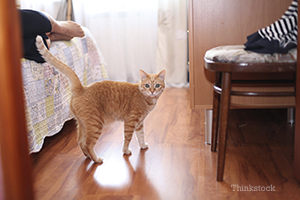
Dr. Ruth MacPete discusses the controversial topic of whether or not cats should be let to roam around freely outdoors. For more from Dr. MacPete, find her on Facebook or at www.drruthpetvet.com!
Despite all the compelling reasons to keep your cat safely indoors, why do so many cat parents still let their feline friends outside?
1. Cats Were Once Wild Animals, Right?
Many people feel cats should be allowed to go outdoors because of their wild origins. Even though cats have been domesticated for nearly 6000 years, they have maintained an obvious connection with their wild ancestors. Scientists believe that cats first became domesticated around 4000 BC in Africa and the Middle East. Most experts think that cats came into contact with humans after people transitioned from hunting and gathering to farming. Cats began to live near human settlements to hunt rodents from the grain storage bins. People quickly recognized the value of their hunting prowess and began to encourage cats to live with them by providing water, food, shelter and even safety from natural predators. The ancient Egyptians revered cats for their beauty as well as their rodent-killing ability. As time passed, cats assumed a new role and became cherished household pets.
For thousands of years, most of the human population lived in rural settings. This was an ideal setting for cats because they were able to assume their new role as pets while providing pest control. They were also able to keep some of their wild habits as they roamed and hunted across large open territories. Following the Industrial Revolution, most of the human population moved into urban settings. As people moved into cities and suburbs, so did their feline friends. Some cats became exclusive household pets but many continued to be allowed to roam outdoors alone. The move from the farm to the city has exposed outdoor cats to new health hazards and unfamiliar urban dangers. As discussed in Part I, outdoor cats can get in fights, get exposed to deadly viruses, hit by cars, attacked by wild animals and can become poisoned. The fact is, times have changed and outdoor cats face a plethora of dangers they once did not.
2. Curiosity: Can It Really Kill The Cat?
Since cats are inherently inquisitive, many people feel they need to be outdoors to fulfill their curiosity. They fear that their cat will be bored if it lives indoors only. There is no doubt that being outdoors can be exciting, but is the thrill worth the health hazards and shortened lifespan? So how can you ensure that your indoor cat stays stimulated? For starters, if you haven’t already, don’t let your cat outside. Like humans, cats will not miss what they do not know. Ask any non-smoker if they miss not being able to smoke a cigarette? Provide your cat an indoor environment that stimulates their senses and their mind with new sights, sounds and smells. You can set-up a bird feeder or birdbath outside a window and place a perch in front of it so that your cat can watch and listen to the birds feeding or bathing. Aquariums are another source of endless entertainment for your cat. Cats also enjoy experiencing different smells and giving them cat grass or catnip will fulfill your cat’s need for aromatherapy. And don’t forget that an active body promotes an active mind. Consider getting a cat tree or a cat tunnel or tent to keep your cat fit. And if your cat is a couch potato, buy a cat video so that your sedentary friend stays stimulated.
3. An Aversion to Kitty Litter
Many people let their cat go outside simply to avoid the hassle of having a litterbox. The fact is scooping a litter box is no one’s idea of fun. Fortunately, there are solutions to help make this chore a little easier. Consider investing in an automatic litter box. These fancy litter boxes can provide you and your cat with a clean environment without the chore of daily litter scooping. Or, with a little effort, you can teach your cat to use the potty. Though they won’t flush the toilet or put the seat down, most cats can be trained to use the toilet with the help of a special potty system that teaches your cat to use the toilet. If you can’t stand the look of a litterbox, another option is to get crafty; some people hide the litter box in furniture or put them under cabinets. The fact is, nowadays there are a number of ways to decrease the hassle of having a litter box. And while it may not be fun to scoop a litter box, it beats paying unnecessary veterinary bills if your cat gets hurt.
As a shelter veterinarian, I see lost and injured cats brought in all the time. These experiences have convinced me that cats should be kept indoors in the safety of a warm, loving home. I hope this information will help you understand why so many veterinarians and animal experts agree with this position. The decision to keep your cat indoors is an important one that can help your cat live a longer and healthier life. It could even save you money in the long run!
If you have any questions or concerns, you should always visit or call your veterinarian – they are your best resource to ensure the health and well-being of your pets.
The opinions and views expressed in this post are those of the author's and do not necessarily represent the beliefs, policies or positions of PetHealthNetwork.com, IDEXX Laboratories, Inc. or its affiliates and partner companies.
